Daily Rice Consumption: How Eating Rice Every Day Affects Your Body
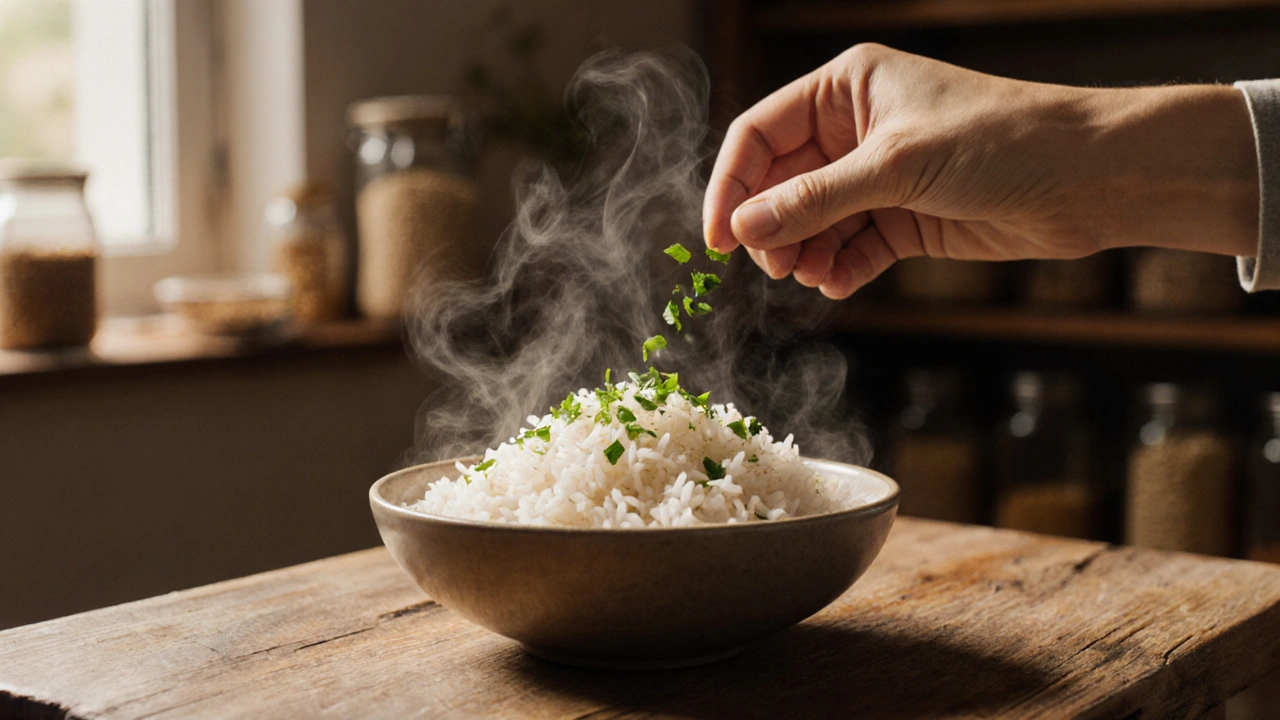
Rice Nutrition & Portion Calculator
Select Your Rice
Your Rice Analysis
Daily value based on 2,000 calorie diet
Health Tips
Ever wonder what happens inside you when you make rice a staple at every meal? This article breaks down the science, the pros, the cons, and the practical tips you need to decide if a bowl of rice every day is a boost or a burden for your health.
What Rice Actually Is - A Quick Nutrient Snapshot
Rice is a cereal grain that supplies mainly carbohydrates, a modest amount of protein, and trace amounts of fat. Most of the calories come from starch, while the exact nutrient mix varies by variety (white, brown, basmati, jasmine, etc.). A typical cooked cup (about 158g) of white rice provides roughly 200kcal, 45g of carbohydrate, 4g of protein, 0.4g of fat, and less than 1g of dietary fiber. Brown rice adds about 1.8g of fiber and a few extra minerals such as magnesium, phosphorus, and selenium.
Key nutrients per cup of cooked rice:
- Carbohydrate: ~45g
- Protein: 4-5g
- Fiber (brown only): 1.8-3.5g
- Calories: 200-215kcal
- Minor minerals: manganese, selenium, small iron
How Daily Rice Impacts Blood Sugar and Insulin
Carbohydrates are broken down into glucose, which fuels every cell. The speed of that breakdown is expressed by the glycemic index (GI). White rice typically scores 70-80 (high GI), meaning it spikes blood glucose quickly. Brown rice usually lands in the 50-55 range (moderate GI), leading to a gentler rise.
When you eat rice every day, especially the high‑GI white kind, your pancreas releases insulin to shuttle glucose into muscles and the liver. Repeated spikes can blunt insulin sensitivity over months, a phenomenon known as “insulin resistance.” For most healthy adults, occasional spikes are fine, but chronic high‑GI intake may increase the risk of type2 diabetes, especially when paired with low physical activity.
Practical rule of thumb: combine rice with protein (fish, tofu, beans) and fiber‑rich veg to lower the overall GI of the meal. This mix slows digestion, flattening the glucose curve and easing the insulin load.
Energy, Satiety, and Caloric Balance
Because rice is dense in carbohydrate, it provides quick‑acting energy-perfect for morning workouts or a high‑intensity training session. A 158g serving supplies about 45g of carbs, translating to roughly 180kcal of usable fuel.
However, satiety (the feeling of fullness) depends on more than calories. Fiber, protein, and water volume are the true satiety drivers. White rice lacks fiber, so a bowl may leave you hungry sooner, nudging you to snack later and potentially push you above your daily calorie target. Brown rice’s extra fiber helps you feel fuller longer, making it a better choice for weight‑management goals.
If you’re counting calories, remember that a typical serving of rice can eat up a large chunk of a 2,000‑kcal day. Adjust portion sizes (½cup cooked for moderate intake) or pair with low‑calorie vegetables to keep the energy balance in check.
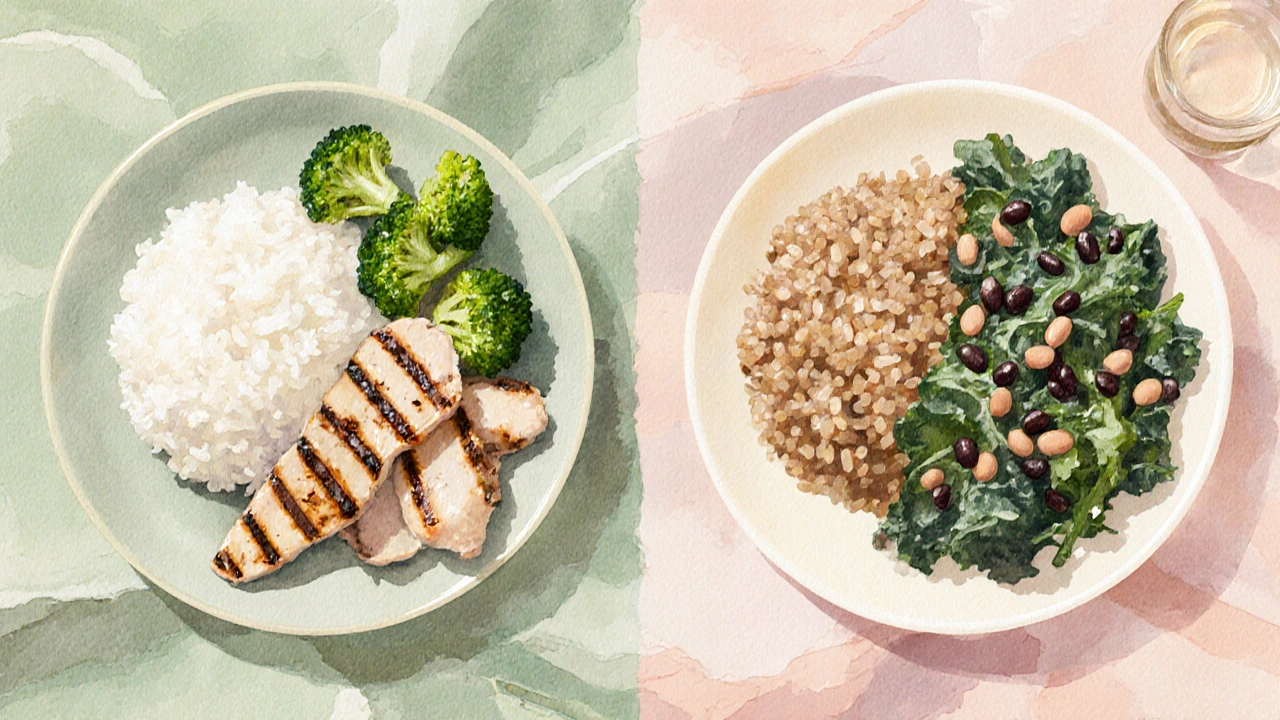
Weight, Body Composition, and Athletic Performance
For athletes, carbohydrate timing matters. Consuming rice 2-3hours before training replenishes glycogen stores, supporting endurance and high‑intensity bursts. Post‑workout, a rice‑plus‑protein meal accelerates glycogen restoration and muscle repair.
For weight‑loss seekers, the picture is mixed. A study from the Journal of Nutrition (2023) compared 100participants on a rice‑centric diet versus a diversified grain diet for 12weeks. Both groups lost similar weight (≈4kg), but the rice group reported higher hunger scores and slightly lower lean‑mass retention. The takeaway? Rice can fit a weight‑loss plan, but you need to watch portion size and ensure enough protein and veg to protect muscle.
In short, rice delivers the carbs athletes crave, but it’s not a magic bullet. Balance it with protein, healthy fats, and micronutrient‑rich foods for optimal body‑composition outcomes.
Micronutrients, Fiber, and Gut Health
Beyond carbs, rice offers modest amounts of B‑vitamins (thiamine, niacin) that aid energy metabolism. Brown rice also supplies magnesium, which supports muscle function and bone health.
Fiber, especially in whole‑grain rice, feeds beneficial gut bacteria. Short‑chain fatty acids produced by fermentation (like butyrate) improve intestinal barrier function and may reduce inflammation. However, a diet that relies heavily on white rice can be low in fiber, potentially leading to constipation and a less diverse microbiome.
To boost gut health while eating rice daily, add a side of legumes, leafy greens, or a small salad. This strategy increases overall dietary fiber without sacrificing the convenience of a rice base.
Potential Risks - Arsenic, Nutrient Gaps, and Over‑Reliance
One often‑overlooked issue with daily rice is inorganic arsenic, a naturally occurring toxin absorbed from soil and water. Long‑term high‑arsenic exposure is linked to skin, lung, and bladder cancers. The FDA recommends varying grains and rinsing rice thoroughly before cooking to reduce arsenic content.
Another risk is nutrient monotony. If rice is the primary grain, you may miss out on nutrients abundant in quinoa, oats, or barley-such as iron, zinc, and certain phytonutrients. A varied grain palette ensures a broader nutrient spectrum.
Lastly, people with specific conditions (e.g., Polycystic Ovary Syndrome, metabolic syndrome) may benefit from lower‑GI carbs, making brown rice or alternative grains a smarter daily choice.
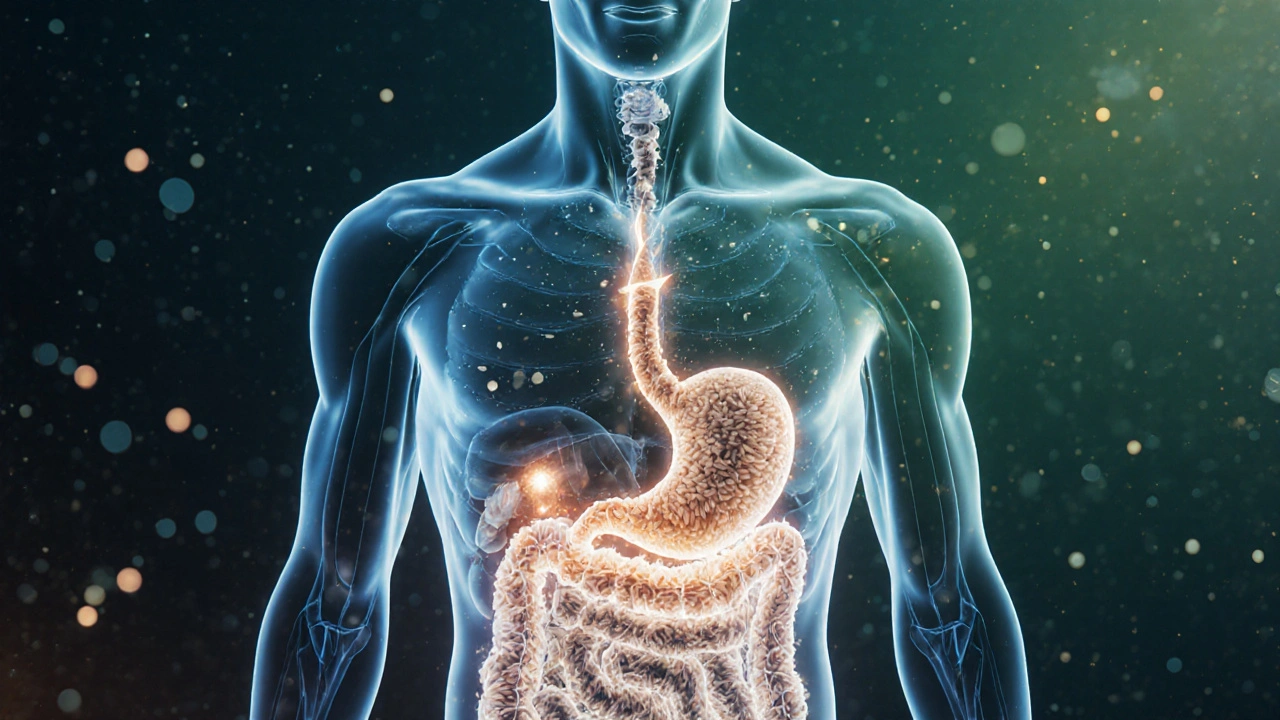
Practical Tips - Making Daily Rice Healthy
Here are five easy steps to keep rice a beneficial part of your routine:
- Choose whole‑grain varieties whenever possible. Brown, red, or black rice supply extra fiber and antioxidants.
- Rinse the rice three times before cooking. This removes surface starch and cuts arsenic by up to 30%.
- Control portions. A half‑cup cooked (≈100g) provides ~130kcal and is a good base for a balanced plate.
- Pair with protein and veg. A classic combo-grilled chicken, steamed broccoli, and a scoop of rice-lowers the meal’s overall GI and boosts satiety.
- Rotate grains weekly. Swap in quinoa, millet, or barley to diversify micronutrients and keep arsenic exposure low.
Comparison of Common Rice Types
| Rice Type | Calories | Carbs (g) | Fiber (g) | Glycemic Index | Key Micronutrients |
|---|---|---|---|---|---|
| White (long‑grain) | 205 | 45 | 0.6 | 72 | Thiamine, small iron |
| Brown (short‑grain) | 215 | 45 | 3.5 | 55 | Magnesium, selenium, B‑vitamins |
| Black (wild‑style) | 165 | 35 | 4.0 | 45 | Anthocyanins, iron, zinc |
| Basmati (white) | 190 | 40 | 0.9 | 58 | Low sodium, some B‑vitamins |
Bottom Line - Is Daily Rice Right for You?
If you love rice, there’s no need to ditch it completely. A moderate portion of whole‑grain rice, rinsed well, and paired with protein and vegetables can support steady energy, gut health, and even athletic recovery. The main caveats are watching portion size, balancing the overall diet to avoid nutrient gaps, and varying your grains to keep arsenic exposure low.
In the end, the impact of eating rice every day hinges on *how* you eat it. Treat rice as a flexible building block, not the only block, and you’ll reap the carbs you need without the hidden drawbacks.
Frequently Asked Questions
Does white rice cause weight gain?
Weight gain depends on total calories, not the grain alone. White rice is calorie‑dense and low in fiber, so if you eat large portions without balancing protein and veg, you may exceed your energy needs and gain weight.
Is brown rice a better choice for athletes?
Brown rice offers more fiber and a lower GI, which can help sustain energy during long sessions. However, white rice’s quicker digestion makes it useful right before high‑intensity bursts. Many athletes alternate both types based on timing.
How much rice is safe to eat daily?
A typical safe portion is ½cup cooked (about 100g) for most adults. This supplies roughly 130kcal and fits well into a balanced plate with protein and vegetables.
Does rice contain gluten?
Rice is naturally gluten‑free and safe for people with celiac disease or gluten sensitivity.
How can I reduce arsenic in rice?
Rinse the rice several times, use a 6:1 water‑to‑rice ratio and drain excess water, or cook it using the "pasta method" (boil, then drain). Rotating grains also lowers cumulative arsenic exposure.




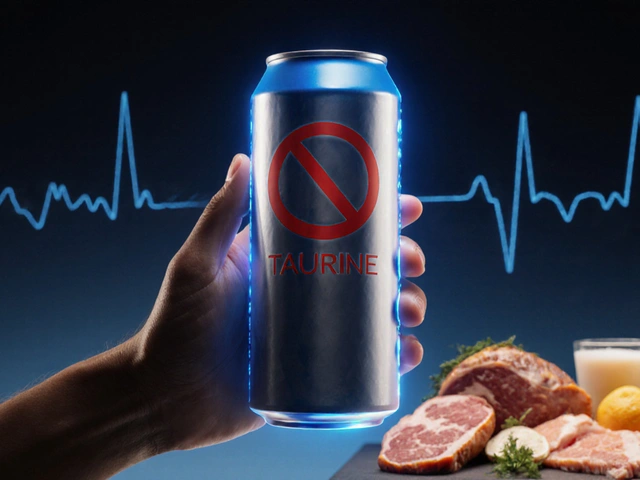
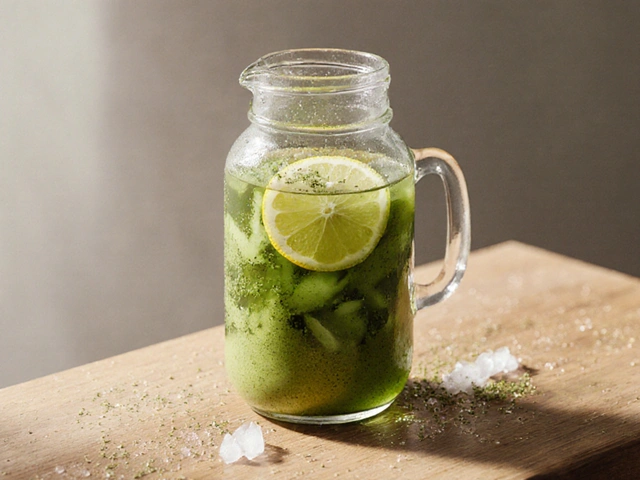
Comments (12)
King Medoo
5 Oct 2025
Honestly, if you’re willing to let a single grain dominate your diet, you should at least be aware of the broader implications. Rice is a carbohydrate powerhouse, but it’s also a cultural staple that has shaped societies for millennia. 🍚 While many glorify its convenience, the high glycemic index of white varieties can wreak havoc on insulin sensitivity over time. This isn’t just a casual health tip – it’s a call to responsibility for anyone who thinks of eating rice daily as a harmless habit. 🩺 Moreover, the arsenic content, especially in rice grown in certain regions, is something regulators have flagged for years. Ignoring those warnings is akin to turning a blind eye to known public health concerns. 🙈 In the grand scheme, your plate should be a balanced ecosystem, not a monoculture of starch. So, embrace variety, rinse your rice, watch your portions, and don’t let convenience become a silent saboteur of your well‑being. 🌱✨
Rae Blackburn
6 Oct 2025
i cant believe people still push rice as the ultimate health food its a trap set by unseen forces controlling our food supply and they dont tell us about the mercury hidden in the grains we see through the veil they hide the truth
LeVar Trotter
7 Oct 2025
Let’s unpack the metabolic ramifications of incorporating rice as a quotidian staple in a nutritionally adequate diet. Firstly, the carbohydrate load inherent to a standard cup of cooked rice approximates 45 g, thereby delivering a rapid influx of glucose into the systemic circulation. When juxtaposed with a low‑GI carbohydrate source, the resultant post‑prandial glycemic excursion is markedly attenuated, mitigating the demand placed upon pancreatic β‑cells for insulin secretion. Secondly, the dietary fiber content, especially pronounced in whole‑grain variants such as brown or black rice, exerts a modulatory effect on satiety signals via delayed gastric emptying and enhanced colonic fermentation. This, in turn, yields short‑chain fatty acids like butyrate, which have been implicated in improved intestinal barrier integrity and anti‑inflammatory pathways. Thirdly, the micronutrient profile of rice, albeit modest, contributes essential B‑vitamins (thiamine, niacin) that serve as cofactors in aerobic energy metabolism, while mineral constituents such as magnesium facilitate neuromuscular function and glucose homeostasis. Fourth, the potential for inorganic arsenic accumulation-particularly in rice cultivated under high‑arsenic soils-necessitates mitigation strategies, including multiple rinses and the adoption of a rice‑to‑water ratio conducive to leaching. Fifth, from an athletic performance perspective, timing of carbohydrate ingestion is crucial; pre‑exercise consumption of rice 2–3 hours prior can replenish glycogen stores, whereas post‑exercise carbohydrate‑protein co‑ingestion optimizes glycogen resynthesis and muscle protein synthesis. Sixth, epidemiological data suggest that exclusive reliance on a single grain may precipitate nutrient monotony, potentially compromising intake of phytonutrients abundant in alternative cereals like quinoa or millet. Seventh, the thermic effect of food (TEF) for carbohydrate‑rich meals is comparatively lower than that of protein‑dominant meals, influencing total daily energy expenditure. Eighth, habitual consumption of high‑GI rice without concurrent protein or fiber may exacerbate insulin resistance trajectories, especially in sedentary cohorts. Ninth, the culinary versatility of rice permits integration with legumes, vegetables, and lean proteins, thereby facilitating a macronutrient‑balanced plate that adheres to dietary guidelines. Tenth, portion control remains a pivotal factor; a half‑cup of cooked rice (~100 g) yields roughly 130 kcal, aligning with a 2,000‑kcal diet when combined with nutrient‑dense accompaniments. Eleventh, public health recommendations underscore the importance of grain diversity to ameliorate micronutrient deficiencies on a population level. Twelfth, cultural considerations-such as traditional fermentation or sprouting techniques-can enhance bioavailability of nutrients and reduce antinutrient load. In synthesis, the inclusion of rice in daily meals is not inherently detrimental; its impact is contingent upon grain variety, portion size, preparation method, and overall dietary context. By judiciously selecting whole‑grain forms, employing proper rinsing techniques, and pairing rice with protein‑rich and fiber‑dense foods, one can harness its energy‑providing benefits while mitigating associated risks.
Seraphina Nero
8 Oct 2025
I hear you on the need for balance. Rice can be part of a healthy plate when you add some veggies and protein. It’s cool that you highlighted the arsenic thing – not many think about that. Just remember to rinse it well and watch portion sizes. Keeping it simple can still be nutritious.
Megan Ellaby
9 Oct 2025
so i was thinkin bout trying out the brown rice thing i read about in the article its kinda pricier but im curious if the extra fiber is really worth the $$$ or if i should just stick to white cuz its easier to cook and tastes better
E Jones
11 Oct 2025
Listen, there’s a clandestine agenda humming behind those seemingly innocent grain packets on supermarket shelves. The manufacturers, in collusion with shadowy agribusiness lobbies, have been stealthily boosting the arsenic content of certain rice strains to keep us dependent on their “fortified” products. Every time you rinse your rice, you’re only scrubbing away a fraction of the invisible toxins they’ve embedded, leaving the rest to infiltrate our bodies like tiny saboteurs. The whole "just eat a balanced diet" mantra is a smokescreen, a narrative spun to mask the fact that the very staple that feeds billions is also a vector for chronic disease. It's not just about GI or calories; it’s about control, manipulation, and the quiet erosion of public health. So the next time you reach for that bag, consider who benefits from your bowl of carbs. 🌐
Addison Smart
12 Oct 2025
Alright folks, let’s step back and look at this from a cultural and nutritional perspective. Rice isn’t just a food; it’s a symbol woven into the fabric of countless societies, from Asian night markets to Southern comfort plates. That heritage carries both wisdom and cautionary tales. Traditional practices-like soaking, fermenting, or cooking rice in excess water-have evolved precisely because they address the very concerns we’re discussing: glycemic load, arsenic, and nutrient bioavailability. Modern convenience foods often strip away these time‑tested methods in favor of speed, which can unintentionally increase health risks. By re‑integrating these practices, we honor cultural heritage while enhancing the safety of our meals. Moreover, embracing grain diversity-mixing rice with quinoa, barley, or millet-can break the monotony and broaden our micronutrient intake. This approach not only mitigates arsenic exposure but also enriches the diet with proteins, essential amino acids, and antioxidants that rice alone may lack. So, let’s celebrate rice for what it offers, but also recognize that it’s just one piece of the puzzle. Balance, tradition, and informed choices are the keys to turning a simple bowl of rice into a genuinely healthy staple.
David Smith
13 Oct 2025
Well, look at you diving deep into rice history like it’s the holy grail. Meanwhile, most of us just want a quick side without the lecture. Sure, tradition’s cool, but does anyone really have time to soak rice for hours? And mixing quinoa? Yeah, nice in theory, but my grocery budget can’t handle a grain swap every week.
Lissa Veldhuis
14 Oct 2025
Honestly, the whole "balanced plate" talk is just a marketing ploy to make you feel better about eating processed stuff. People who swear by rice are just following the herd without realizing they're feeding themselves a slow‑acting toxin. Wake up!
Michael Jones
15 Oct 2025
Think about the bigger picture-our bodies are engines that need quality fuel, not cheap filler. When we prioritize convenience over nutrition, we end up with metabolic drift, less energy, and long‑term health costs. Choose wisely, invest in real food.
Abert Canada
16 Oct 2025
Yo, just tossing my two cents in-mixing up grains keeps things interesting and cuts down on that arsenic worry. I’ve been swapping half my rice for barley and it’s been solid. Anyone else tried that?
Xavier Lévesque
17 Oct 2025
Sure, grains are fine.